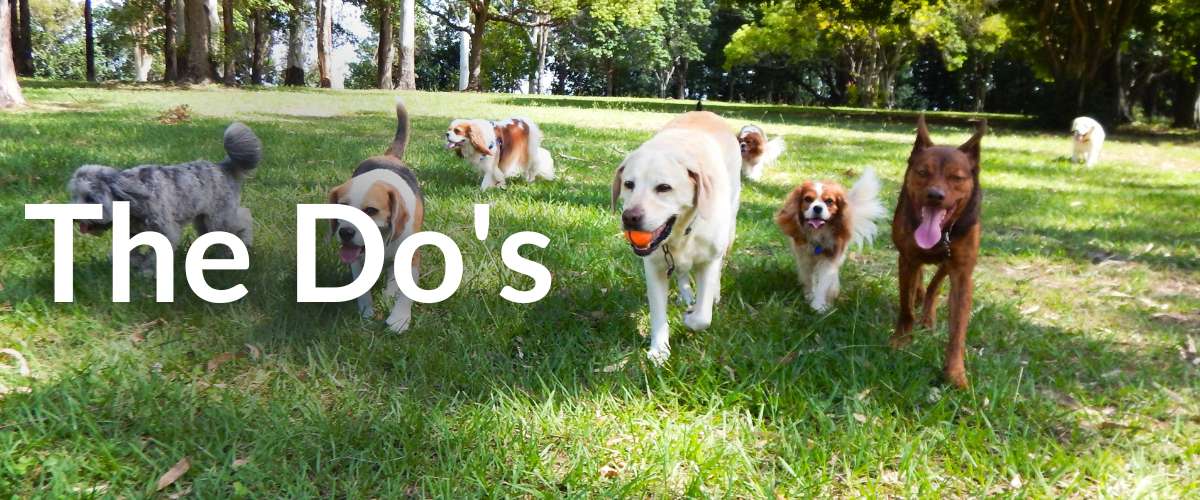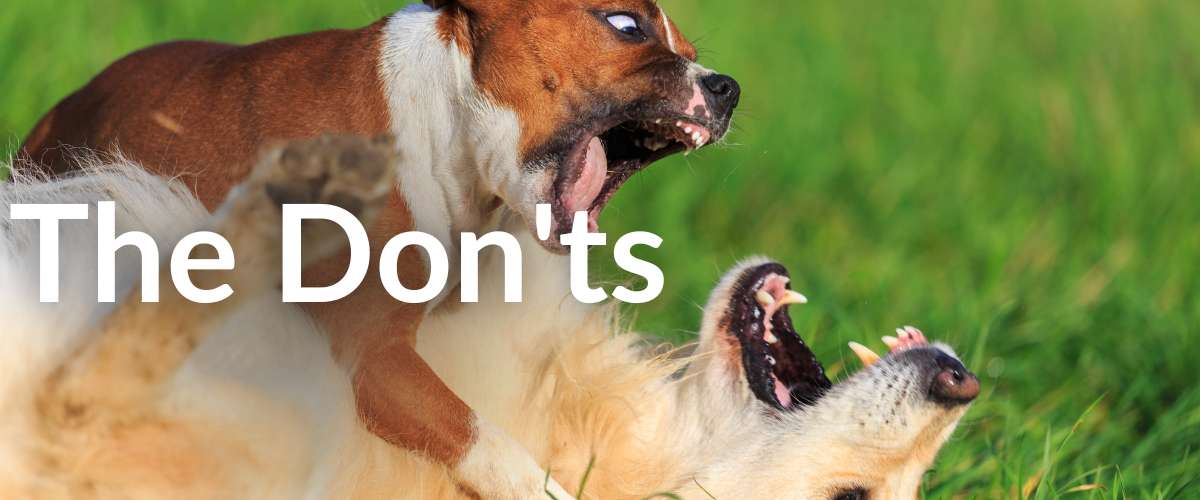The dog park – or as we lovingly have to call it, the “P-A-R-K” – what better place to run some laps, meet new pals and sniff a few butts? Um, let us clarify, we’re not talking about a magical place for you. We’re talking about your dog here. We don’t recommend you go sniffing butts.
That was awkward. Do you know what else is awkward? Not following the rules, especially at the dog park. Sure, signs may be posted, but there’s also a set of unspoken rules or etiquette to consider when making a trip to your pup’s favorite communal hangout spot. By practicing proper dog park etiquette, you help foster a fun and safe environment for you, your dog and everyone else at the park. It can lead to the opposite when not followed, and that’s no fun for anyone.
Thankfully, we’ve compiled a guide of the best do’s and don’ts when it comes to a day out at the p-a-r-k.
Before Making The Trip
You should ask yourself a few questions before taking your furry pal to the dog park. We’d recommend you ask your dog first because it’s so cute to watch their head do that thing when they hear the word “park.” Ok, now to the important stuff:
Is my dog responsive to basic cues?
Dog parks are naturally full of distractions, including people, other dogs, strange outdoor smells, and, of course, exciting local wildlife (we’re lookin’ at you, squirrels). Making sure your dog knows fundamental commands like “come,” “sit,” “stay, and “leave it” means that you are both more likely to avoid unwanted incidents at the park that could pose a threat to your pup or another. In fact, many dog parks require that your dog is under voice command in accordance with the local ordinance. The last thing you’d want is for Fido running away from you as you’re screaming, “C’MERE BOY!” so a quick internet search on your communities requirements is always a good idea.
Is my dog licensed?
That’s right, your pet’s most important accessory is also their admission to their favorite place. The vast majority of dog parks require a dog to wear their official license tag on their collar upon entering a public dog park. Your pet’s license proves that they are up-to-date on vaccinations and shows that you are a responsible pet owner with the public’s safety in mind (go you). Some communities may also require additional proof, such as off-leash permits – be sure to familiarize yourself with your community’s local laws before emBARKing on a trip to the park.
Is my dog in good health?
This one is obvious but still very important to consider: skip the dog park if your dog is under the weather or in poor health. Parks are a breeding ground for germs, and the last thing you’d want is to be the cause of a community-wide outbreak. If your furry pal is mending a muscle sprain or has some stitches that need to heal, they need rest, not the temptation of a wide-open park to run around with their neighborhood friends. Additionally, dogs who are in heat or pregnant should not go to a dog park.
Is my dog old enough?
At the very least, owners should wait until their dog is at least six months old and fully vaccinated with their core puppy vaccinations before bringing them to a dog park. These vaccinations keep your dog and others safe from preventable illnesses like Canine Parvovirus and rabies, and in a number of communities, dogs are required to be vaccinated against rabies in order to obtain a license. Unvaccinated puppies (and adult dogs) are incredibly susceptible to parvo, a highly contagious and deadly virus that can live outdoors for months at a time.
Is my dog ready?
Before heading to the park, it’s important to ensure your dog is comfortable being around other dogs; as much as we may think it’s paradise on earth for them, dog parks can be stressful for some of our furry pals! Being around other people and animals may overwhelm shy or anxious dogs, which is especially true for puppies and dogs who have trouble controlling their reactivity.
If a dog has behavioral issues, is aggressive, or isn’t comfortable around other dogs or people, they should avoid dog parks altogether. Dog parks are not the right place to work on fixing behavior issues and should be done in a controlled environment, like at home or with a trainer.
Now that those questions are out of the way, let’s jump into it!

Do Follow The Rules
No two dogs are the same, and the same can be said for dog parks. Ensure you are familiar with the park regulations, typically set by each city or town and posted at the entrance. Rules are there to ensure the safety of all pets and visitors.
No rules posted? Try a quick internet search!
Do Come Prepared
A dog is obviously number one on the list of things to bring to the dog park, but you should consider bringing a few other things with you, such as:
- Water
- Try using a collapsible bowl or a doggy water bottle to make drinking super easy for your dog – especially important on those hot and sunny days!
- Poop bags
- Probably the #1 faux paws (get it?)- not picking up after your pet. Though many parks provide poop bags as a courtesy, it’s best to bring your own, just in case.
- First aid kit
- Hopefully you never have to use it, but having a first aid kit on hand will ensure you’re prepared for any situation.
- Leash
- Dogs should remain on a leash until they are safely inside the park.
- Treats
- Leave these in the car until after to reward your pup for a good outing.
Do Pick Up After Your Dog
Need we say more? Pick up after your pups, people! Not only does 💩 have the potential to find its way to the bottom of someone’s shoe but there are other repercussions of waste in the environment. Leftover waste can potentially contaminate nearby water and linger in the ground for years. Additionally, bacteria and parasites found in pet waste can spread illnesses like parvo and salmonella among animals. Oh, and of course, there is also a monetary fine if you’re caught in the non-act of picking up after your pet – now that’s really poopy.
Do Have A Collar And License Tag On
Even if the dog park is fenced in and enclosed, ensure your dog is equipped with their trusty collar and tag. Dog parks are typically enclosed and designed to keep your pet in a safe, designated area, but this is not always the case! Some larger parks are not fenced in (know that before you go), and of course, unexpected surprises such as human error (forgetting to close a gate) or animal edits (digging a getaway hole under the fence) are to be expected. Should your dog find a way out, their license tag means they’ll make it back to you.
BONUS: if your pet has a DocuPet tag, you can rest easy knowing they are protected by our HomeSafe™ 24/7 lost pet service. Each tag links to that pet’s online profile via a unique 8-digit code etched on the back, which is used to report them as found to our HomeSafe™ dispatch team. Learn more about how we’ve reunited thousands of lost pets with this service here.
Do Take It Slow
If your dog is new to the dog park, give them time to adjust to the experience. Keep your first few trips short and gradually increase your time there as your dog gets more comfortable.
Remember: some dogs may not do well with dog park visits, which is okay. If a dog isn’t totally on board with dog parks, there are plenty of other options for you to burn off that extra energy while getting some quality time in the books! Try leashed walks, off-leash trails, hikes and physical activities like frisbee or agility.
Don’t Ignore Body Language
Dogs can’t speak, so we rely on their body language to tell us exactly how they feel. Understanding body language in dogs is essential for their safety. Here are a few signs of anxiety and fear in dogs:
- Heavy breathing
- Hiding
- Excessive drooling
- Fleeing
- Shaking
- Aggression
- Tucked tail
Having a solid comprehension of when/if you need to intervene in a situation is critical. If you spot any of these signs, remove your dog from the situation immediately, as a fight could be imminent:
- Bullying
- Body slams
- Snarling
- Incessant following
- Excessive mounting
Of course, every dog is unique and may respond to situations using different body language than what is listed here.
Don’t Get Distracted
Your dog depends on you to keep them safe, so keep your eyes locked on them while off-leash. We know Candy Crush is addicting, but put that phone away and monitor your dog’s interactions with others to make sure they are playing safely. Problems happen when you least expect them, so keep your dog safe by being present! It’s important to pay attention so you can prevent any problems before they have the chance to pop up.
What’s that old saying? “A watched phone never rings.” That’s it, but let’s add a twist for argument’s sake– “a watched dog is kept safe.”
Don’t Allow Your Dog To Be A Bully
This one might be obvious to us humans, but dogs can be bullies, too! Keep an eye out for bullying behaviors from your dog and others. This can include relentless chasing, aggressive pushing, pinning other dogs to the ground, and ignoring appeasement cues. Some dogs like to play rough, but it’s important to understand how other dogs react to this behavior. If a dog engages in this play with another, they could very well be having fun. If they are showing signs of concession or are trying to get away, odds are they are not enjoying it. For this reason, it’s very important not to have dogs in heat at the dog park. Communication with other pet owners is key here. Vocalize your pet’s habits and ensure those around you are aware and comfortable – what’s normal to you is new to someone else!
Don’t Let Your Dog Mount
There’s always that one dog who has to make it weird. Don’t be that dog. If you see your dog mounting or being mounted, intervene. You can do this by blocking the dog and stepping in between them. The pursuer may keep attempting after being told “no,” so repeat as many times as needed to get the point across. Mounting behavior is often used to assert dominance over another dog and can lead to conflict, even if the dog means no harm. This is another instance where it’s super important to communicate with the other pet owners around you.
Don’t Keep Their Leash On
A dog’s leash should be removed before or as soon as they enter the unleashed area of the park. Not only does a leash create a tripping hazard for them and other dogs, but mixing a leashed dog with unleashed dogs can cause stress to the leashed dog, which in turn could lead to aggression. As a safety precaution, some parks have a designated, fenced-in area at the entrance where you can safely remove your dog’s leash before entering the off-leash area. This “holding area” helps prevent dogs from getting spooked or overwhelmed and running off sans leash. Some parks even offer dedicated leashed and off-leash areas so you and your pup can play at your own comfort level!
Dog parks are the sport for dogs and their owners to socialize and have fun, but only when everyone plays by the rules. By doing so, you create a positive culture and environment for everyone, but most importantly, your dog.
Plus, your dog gets to sniff literally so many butts. Hey, we won’t judge.



